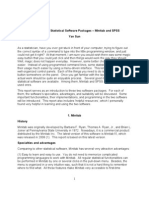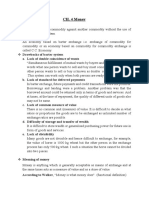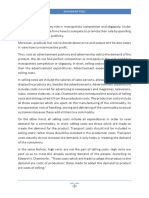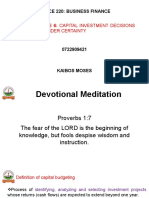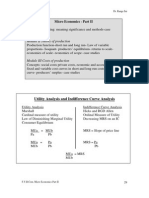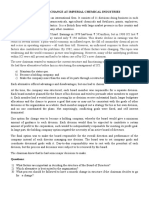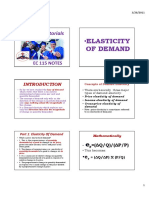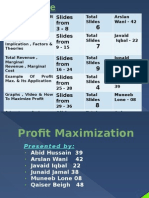Money
Money
Uploaded by
MD. IBRAHIM KHOLILULLAHCopyright:
Available Formats
Money
Money
Uploaded by
MD. IBRAHIM KHOLILULLAHCopyright
Available Formats
Share this document
Did you find this document useful?
Is this content inappropriate?
Copyright:
Available Formats
Money
Money
Uploaded by
MD. IBRAHIM KHOLILULLAHCopyright:
Available Formats
Lecture 1: Introduction
Definition of Money:
Money is a generally accepted medium for the exchange of goods and services, for measuring
value, or for making payments.
Different economists defined money in different ways, such as,
“Money is what money does.”- Francis Walker.
Money is “one thing that possesses general acceptability.”- E.R.A. Seligman.
Money is “anything that is generally acceptable as a means of exchange and which at the same
time, acts as a store of value.”- Crowther.
Therefore, money is any item or verifiable record that is generally accepted as payment for goods
and services and repayment of debts in a particular country or socio-economic context.
Chronological Development of Money
The money was not invented but it evolved with passage of time according to the changing
requirements of economies.
It is generally believed that evolution of money has passed through following six stages.
1. Barter
2. Commodity Money
3. Metallic Money
4. Paper Money
5. Credit Money
6. Electronic Money
These stages of evolution of money are discussed as under.
1. Barter:
In the beginning of civilization the needs of people were very limited and therefore they
used to exchange their goods with other people’s goods or Service.
Such a system of exchange where goods and services are directly exchanged for each
other without the use of money is called barter system.
As for examples- corn may be exchanged for ox hides, lemons for orange, shoes for shirts
and so on.
2. Commodity Money:
In the earliest period of human civilization, any commodity was chosen to serve as
money depends upon various factors like location of the community, climatic
environment of the region, cultural and economic standard of society etc.
Mousumi Saha, Lecturer, Department of Statistics, EBAUB Page 1
For example, people living in the seashore adopted shells and dried fishes as money.
African people used ivory and tiger jaws as money
3. Metallic Money:
With the progress of human civilization, commodity money changed into metallic
money.
Metals like gold, silver, copper, etc. were used, as they could be easily handled and their
quantity can be easily ascertained.
4. Paper Money:
It was found inconvenient as well as dangerous to carry gold and silver coins from place
to place. So, invention of paper money marked a very important stage in the development
of money.
Paper money is regulated and controlled by Central bank of the country.
5. Credit Money:
People keep a part of their cash as deposits with banks, which they can withdraw at their
convenience through cheques.
The cheque (known as credit money or bank money), itself, is not money, but it performs
the same functions as money.
6. Plastic Money:
The latest type of money is plastic money in the form of Credit cards and Debit cards.
They aim at removing the need for carrying cash to make transactions.
Functions of money
Money solves the problems created by the barter system.
First, money serves as a medium of exchange, which means that money acts as an
intermediary between the buyer and the seller. It is accepted freely in exchange for all other
goods.
Mousumi Saha, Lecturer, Department of Statistics, EBAUB Page 2
Second, money must serve as a store of value. Holding money is a much easier way of
storing value. We do not need to spend it immediately because it will still hold its value the
next day, or the next year.
Third, money also functions as a unit of account, providing a common measure of the value
of goods and services being exchanged. Knowing the value or price of a good, in terms of
money, enables both the supplier and the purchaser of the good to make decisions about how
much of the good to supply and how much of the good to purchase.
Finally, another function of money is that money must serve as a standard of deferred
payment. Deferred payments are known as those payments which are to be made in the
future. Money enables borrowing and lending easier.
The four prominent functions of money can be summed up in the following couplet:
Money's a matter of functions four,
A Medium, a Measure, a Standard, a Store.
These functions are important for social, psychological and economic development of the
society.
Properties/Qualities/Merits of Good Money:
The commodity which is to serve as money should have following properties or qualities:
(1) General Acceptability:
The most important property of money is this that it should be generally acceptable. Any commodity
which lacks this quality cannot be accorded as money. The general acceptability can be possible if any
commodity possesses at least any one of the followings:
(i) Own Value of the Commodity: Gold and silver coins became the money because they were
possessing their own value.
(ii) Legal Position: The coins and currency notes are accepted as money because they have legal backing.
(iii) Confidence: Cheques, drafts and credit cards are money because they are accepted on the ground of
confidence.
(2) Divisibility:
The commodity which is to be money should have the quality of divisibility so that the goods in smaller
quantities could be purchased. The cows and goats were not good money because they could not be
subdivided into smaller parts.
Mousumi Saha, Lecturer, Department of Statistics, EBAUB Page 3
(3) Cognizability:
The good money is one which could easily be cognized. If it does not happen, the counterfeit currency
will come into circulation. As a result, so many problems will rise.
(4) Transportability:
Being good money a commodity should have the quality of transportability. The boats, goats and other
metallic coins did not prove to be the good money because it was difficult to transport them. On the other
hand, the credit money issued by banks, central bank or by govt. has the quality of transportability.
(5) Durability:
It is something necessary for good money that it must be durable. If any commodity gets stale; or it is
perishable; or it gets infected such commodity would not be called as money. In ancient days in Rome the
soldiers were given the salt as their payment. But during rain etc., it would get wet. Accordingly, it was
not good money. On the other hand, the coins and paper currency are the good money because they are
durable.
(6) Standardizability:
Good money is one whose all units are alike with respect to their size, quality and design etc. While the
commodity which lacks such all cannot be accorded as good money. As in American colonies the tobacco
was used as money. But it differed in quality. Accordingly, it did not serve as good money. On the other
hand the gold coins were the good money because their size and weight was same. Again, the paper
currency is good money because of standardization.
(7) Malleability:
The good money is one which could easily be melted and stamped. The gold and silver coins proved to be
good money as compared with iron coins because they were easy to melt.
(8) Stability in Value:
The good money is one whose value is stable. The money whose value goes on to change will not be
considered as good money. As after World War I, German Mark observed a greater fall in its value,
people lost confidence in it. Accordingly it did not prove to be good money.
Importance of Money:
a) Exchange and money: The first and major function of money is acting as a medium of exchange.
It denotes the transaction motive of the people. Money is used for exchanging goods and services and not
for its own.
Mousumi Saha, Lecturer, Department of Statistics, EBAUB Page 4
b) Production and money: Monet is the only means to assembling factors of production. It is the main
measurement for determining the value of demand for and supply of goods and services. If value of
demand exceeds value of supply it will encourage the producers to increase their production.
c) Income distribution and money: Income earned from the production process must be distributed
among the factors of production according to their marginal efficiency. And this work has become
possible and easy by the use of money.
d) Consumption and money: individual earns income in terms of money and uses it for purchasing goods
and services. Money gives freedom to the consumers to buy commodities in higher or lower prices.
Consumers can maximize their satisfaction by equalizing the financial sacrifices with marginal utilities of
goods and services in terms of money.
e) Saving and money: money plays very important role in country’s saving creation. It does not need
storehouse to save it. Moreover money in hand provides facility to fulfill any demand. Thus money
provides boundless advantages and people of developed and underdeveloped countries save in terms of
money.
f) Income earning and money: People engaged in any profession earn in terms of money. The wage
provided to the people is of two types- real wage and nominal wage. Both the wages are measured on the
basis of money.
g) Measure of value and money: Money is the measure of value. All things are measured in terms of
money. It helps the valuation of goods and services accurately which was absent in barter system.
h) Lending activities and money: Value of money is more or less stable which facilitates the lending
process of modern economy. In barter system, lending was difficult due to perishability and fluctuation in
value of the commodities. But money has successfully eliminated this problem in lending activities.
i) Trade and commerce and money: Goods and services produced in a country are not only used to
consume internally but also exported to the abroad. The term ‘international trade’ is much more important
in modern times. The medium of export and import and all types of trade and commerce is the money
which increased the speed of business transaction.
j) Capital transformation and money: Capital transformation is done by money. It is especially essential
in establishing production oriented industries. Because all inputs essential for establishing such industries
are bought by money.
k) Economic development and money: Money is the measuring rod of welfare. It is the medium of all
developments because without money there is no input for development.
Mousumi Saha, Lecturer, Department of Statistics, EBAUB Page 5
l) Government income expenditure and money: Government achieves huge amount of resources from
different sources and also spends the same in different sectors. Accounts of all these are kept in money
terms.
m) Storing value and money: Earnings of the people are not fully consumed. Part of them is stored for
future use and investment. This storing activity is possible to do successfully by money only.
Mousumi Saha, Lecturer, Department of Statistics, EBAUB Page 6
You might also like
- Strategic Case Study of HellofreshDocument38 pagesStrategic Case Study of Hellofreshapi-563773782No ratings yet
- 1.1.1 Determinants of Demand ANSWER KEYDocument4 pages1.1.1 Determinants of Demand ANSWER KEYpaulwilson420No ratings yet
- Agency TheoryDocument8 pagesAgency TheoryMD. IBRAHIM KHOLILULLAHNo ratings yet
- Minitab Vs SPSSDocument11 pagesMinitab Vs SPSSsantosh234No ratings yet
- Monetary Standard CHP 3Document7 pagesMonetary Standard CHP 3MD. IBRAHIM KHOLILULLAHNo ratings yet
- Mega Selling Final ViDocument11 pagesMega Selling Final Vikuya totoNo ratings yet
- The Nature and Types of MoneyDocument12 pagesThe Nature and Types of MoneyShiraz KhanNo ratings yet
- Money and BankingDocument34 pagesMoney and Bankingjanu.sunkara06No ratings yet
- Money and Banking: Chapter - 8Document36 pagesMoney and Banking: Chapter - 8Nihar NanyamNo ratings yet
- Bridge Course in EconomicsDocument17 pagesBridge Course in EconomicsProfessor Tarun DasNo ratings yet
- Money NotesDocument6 pagesMoney NotesNavya AgarwalNo ratings yet
- Chapter 3 - What Is MoneyDocument18 pagesChapter 3 - What Is MoneyOmar GzlzNo ratings yet
- Monetary Economics-Unit 1Document62 pagesMonetary Economics-Unit 1Amanda RuthNo ratings yet
- Chapter 6 Types of Leverages-1Document23 pagesChapter 6 Types of Leverages-1Aejaz MohamedNo ratings yet
- Theories of Economic Development 2023Document16 pagesTheories of Economic Development 2023anushikha banerjeeNo ratings yet
- Selling CostsDocument4 pagesSelling CostsDharmaj AnajwalaNo ratings yet
- Determinants of SupplyDocument4 pagesDeterminants of SupplyBhea GutierrezNo ratings yet
- Fnce 220: Business Finance: Lecture 6: Capital Investment DecisionsDocument39 pagesFnce 220: Business Finance: Lecture 6: Capital Investment DecisionsVincent KamemiaNo ratings yet
- 1Document14 pages1Mayank AroraNo ratings yet
- BBS Macroeconomics 2nd YearDocument3 pagesBBS Macroeconomics 2nd YearIsmith Pokhrel50% (2)
- Corporate Social ResponsibilityDocument9 pagesCorporate Social ResponsibilityAmalia Desti ArthaningtyasNo ratings yet
- Cost of Capital PDFDocument37 pagesCost of Capital PDFBala RanganathNo ratings yet
- Balance of Trade and Balance of Payment NewDocument27 pagesBalance of Trade and Balance of Payment NewApril OcampoNo ratings yet
- Ipr Old Q.paper Unit-1Document8 pagesIpr Old Q.paper Unit-1Manthena Narasimha RajuNo ratings yet
- Micro Economics Part IIDocument30 pagesMicro Economics Part IIZac UsafNo ratings yet
- Money and Banking PDFDocument19 pagesMoney and Banking PDFMOTIVATION ARENANo ratings yet
- Consumption and Saving FunctionsDocument17 pagesConsumption and Saving FunctionsAndaleeb Ameeri100% (2)
- Advantages and Disadvantages of Marginal CostingDocument4 pagesAdvantages and Disadvantages of Marginal CostingnileshmsawantNo ratings yet
- Samuelson and Nordhaus ch22 PDFDocument30 pagesSamuelson and Nordhaus ch22 PDFVictor ManatadNo ratings yet
- Case Study On Strategic ManagementDocument1 pageCase Study On Strategic ManagementSatish VarmaNo ratings yet
- Consumption Is An Increasing Function of IncomeDocument18 pagesConsumption Is An Increasing Function of IncomeRajesh Lamba100% (1)
- Problems On Averages and DispersionDocument3 pagesProblems On Averages and DispersionAditya Vighne100% (1)
- Corporate Finance Assignment PDFDocument13 pagesCorporate Finance Assignment PDFسنا عبداللهNo ratings yet
- How Does An Organization Accurately Identify The Elements of Its Own CultureDocument1 pageHow Does An Organization Accurately Identify The Elements of Its Own CultureDjahan RanaNo ratings yet
- Chapter 10 - Aggregate Demand IDocument30 pagesChapter 10 - Aggregate Demand IwaysNo ratings yet
- Money Supply and Money Demand (File 4)Document21 pagesMoney Supply and Money Demand (File 4)Sadaqatullah NoonariNo ratings yet
- Market Equilibrium Chapter ThreeDocument20 pagesMarket Equilibrium Chapter ThreeAli TreeshNo ratings yet
- Course Outline Financial Markets & InstitutionsDocument6 pagesCourse Outline Financial Markets & Institutionskonica chhotwaniNo ratings yet
- Ignou AssignmentDocument8 pagesIgnou AssignmentAman VermaNo ratings yet
- The Tobin's Q Theory of InvestmentDocument3 pagesThe Tobin's Q Theory of InvestmentGodwinUddinNo ratings yet
- Liquidity Preference As Behavior Towards Risk Review of Economic StudiesDocument23 pagesLiquidity Preference As Behavior Towards Risk Review of Economic StudiesCuenta EliminadaNo ratings yet
- BIF Capital StructureDocument13 pagesBIF Capital Structuresagar_funkNo ratings yet
- Economies of Scale AND Diseconomies of ScaleDocument21 pagesEconomies of Scale AND Diseconomies of ScalepardeepkayatNo ratings yet
- Unit 1Document80 pagesUnit 1Mohan SharmaNo ratings yet
- Security Analysis & Portfolio Management: Risk & ReturnDocument27 pagesSecurity Analysis & Portfolio Management: Risk & Returnrahu007einstein56uNo ratings yet
- 9.6 Keynesian MultiplierDocument23 pages9.6 Keynesian Multiplierkimmo100% (1)
- Lecture 6: Compensating Wage DifferentialsDocument21 pagesLecture 6: Compensating Wage Differentialsswarnendu_janaNo ratings yet
- Price Elasticity of SupplyDocument4 pagesPrice Elasticity of SupplyM IsmailNo ratings yet
- Introduction To Financial ManagemntDocument29 pagesIntroduction To Financial ManagemntibsNo ratings yet
- Elasticity of Demand: Academic TutorialsDocument6 pagesElasticity of Demand: Academic TutorialsDixie Cheelo100% (1)
- Micro Formula SheetDocument2 pagesMicro Formula SheetMC BulletproofNo ratings yet
- Marketing Management Notes (All)Document17 pagesMarketing Management Notes (All)AanyaNo ratings yet
- Money, Interest, and IncomeDocument35 pagesMoney, Interest, and Incomemkkaran90No ratings yet
- Revised Tobin's Demand For MoneyDocument4 pagesRevised Tobin's Demand For MoneySnehasish MahataNo ratings yet
- Circular Flow of Income MCQDocument4 pagesCircular Flow of Income MCQKishore Kintali100% (1)
- Microeconomics - IntroductionDocument14 pagesMicroeconomics - IntroductionNahidul Islam IUNo ratings yet
- Three Basic Economic ProblemsDocument2 pagesThree Basic Economic ProblemsrudraarjunNo ratings yet
- CH-6-Efficient Capital MarketsDocument9 pagesCH-6-Efficient Capital MarketsMoin khanNo ratings yet
- Competitive Market EquilibriumDocument22 pagesCompetitive Market Equilibriumniralilakhani07No ratings yet
- Function of Money MarketDocument3 pagesFunction of Money MarketAbdullah Nasih ZubirNo ratings yet
- Profit MaximisationDocument42 pagesProfit MaximisationIrfan Jamal100% (1)
- The IS-LM Model: Equilibrium: Goods and Money Markets Understanding Public PolicyDocument37 pagesThe IS-LM Model: Equilibrium: Goods and Money Markets Understanding Public PolicyShashank Shekhar SinghNo ratings yet
- Tabular MethodDocument10 pagesTabular MethodMD. IBRAHIM KHOLILULLAHNo ratings yet
- AuditDocument15 pagesAuditMD. IBRAHIM KHOLILULLAHNo ratings yet
- NGOsDocument10 pagesNGOsMD. IBRAHIM KHOLILULLAHNo ratings yet
- Markt IntegrationDocument40 pagesMarkt IntegrationMD. IBRAHIM KHOLILULLAHNo ratings yet
- Black MoneyDocument4 pagesBlack MoneyMD. IBRAHIM KHOLILULLAHNo ratings yet
- Rubric for final exam-2 ANS 1101Document1 pageRubric for final exam-2 ANS 1101MD. IBRAHIM KHOLILULLAHNo ratings yet
- Chapter 1Document6 pagesChapter 1MD. IBRAHIM KHOLILULLAHNo ratings yet
- Value of Money ch5Document9 pagesValue of Money ch5MD. IBRAHIM KHOLILULLAHNo ratings yet
- Islamic BankingpdfDocument6 pagesIslamic BankingpdfMD. IBRAHIM KHOLILULLAHNo ratings yet
- Concept of Money SupplyDocument7 pagesConcept of Money SupplyMD. IBRAHIM KHOLILULLAHNo ratings yet
- Index Number 2021Document31 pagesIndex Number 2021MD. IBRAHIM KHOLILULLAH100% (1)
- Classification of CreditDocument3 pagesClassification of CreditMD. IBRAHIM KHOLILULLAH100% (1)
- Galgotias University: 3.4.1 3. Plagiarism CheckDocument14 pagesGalgotias University: 3.4.1 3. Plagiarism CheckSandesh BhardwajNo ratings yet
- 526 TableDocument11 pages526 TableAllysson Mae LicayanNo ratings yet
- Chapter 12 Review QuestionsDocument21 pagesChapter 12 Review QuestionsBrahim BelkadiNo ratings yet
- Is The Transfer of Invoice Price Variance Not Updating Item CostDocument10 pagesIs The Transfer of Invoice Price Variance Not Updating Item Costmks210No ratings yet
- Chapter 3 MCQs and Analytical Qs Supply and DemandDocument8 pagesChapter 3 MCQs and Analytical Qs Supply and Demandhamna ikram100% (1)
- FM (Ratio Analysis and Interpretation) - 115648Document11 pagesFM (Ratio Analysis and Interpretation) - 115648EuniceNo ratings yet
- Value Investing With Legends (Greenwald) SP2018Document5 pagesValue Investing With Legends (Greenwald) SP2018maveryqNo ratings yet
- Delegated Portfolio Management and Rational Prolonged MispricingDocument30 pagesDelegated Portfolio Management and Rational Prolonged Mispricingkashif salmanNo ratings yet
- Analysis of Ratios:: Liquidity RatioDocument3 pagesAnalysis of Ratios:: Liquidity RatioAmitesh PuriNo ratings yet
- Accounting For Horizontal Repurchase Agreements - RepossDocument8 pagesAccounting For Horizontal Repurchase Agreements - Reposschris_ohaboNo ratings yet
- How Landed Cost Management and Accounts Payable Accounting FlowDocument5 pagesHow Landed Cost Management and Accounts Payable Accounting Flowjazharscribd100% (2)
- Hampleton Partners Fintech Report 1H2020 FINALDocument12 pagesHampleton Partners Fintech Report 1H2020 FINALPrabha GuptaNo ratings yet
- Money Measurement PrincipleDocument7 pagesMoney Measurement PrincipleAnkita BalNo ratings yet
- Lecture 1 - Introduction To DMDocument32 pagesLecture 1 - Introduction To DMDamir MukumovNo ratings yet
- 9609 s17 QP 22Document2 pages9609 s17 QP 22GodfreyFrankMwakalingaNo ratings yet
- Bản sao của ĐC KTQTDocument14 pagesBản sao của ĐC KTQTDương BanyNo ratings yet
- Managing Interest Rate Risk by Managing DurationDocument6 pagesManaging Interest Rate Risk by Managing DurationVenkat IyerNo ratings yet
- Chapter 7 - Consumer Oriented ECommerceDocument17 pagesChapter 7 - Consumer Oriented ECommerceRama SreeNo ratings yet
- Lecture - 03 - Brand ManagementDocument6 pagesLecture - 03 - Brand ManagementNandan KumarNo ratings yet
- Spree Watch Marketing Plan Summary: Situation AnalysisDocument8 pagesSpree Watch Marketing Plan Summary: Situation AnalysisSreejib DebNo ratings yet
- Cuac208 Tests and AssignmentsDocument8 pagesCuac208 Tests and AssignmentsInnocent GwangwaraNo ratings yet
- Market Price 6 Buffer Stocks SchemeDocument27 pagesMarket Price 6 Buffer Stocks Schemecj7chuahNo ratings yet
- Option Trading Playbook Prior To ExpirationDocument2 pagesOption Trading Playbook Prior To ExpirationRavi RamanNo ratings yet
- Option Pricing Using Trinomial Model With Memoization - Siteng JinDocument10 pagesOption Pricing Using Trinomial Model With Memoization - Siteng Jinapi-262753233No ratings yet
- Waters Hardware Store Completed The Following Merchandising Transactions in TheDocument1 pageWaters Hardware Store Completed The Following Merchandising Transactions in TheAmit PandeyNo ratings yet
- Obv SignalDocument5 pagesObv Signalarenaman0528No ratings yet
- Post-Scarcity ProphetDocument6 pagesPost-Scarcity ProphetZadelin WongNo ratings yet
- International Fund RaisingDocument13 pagesInternational Fund Raisingsweetu_bharatiNo ratings yet



